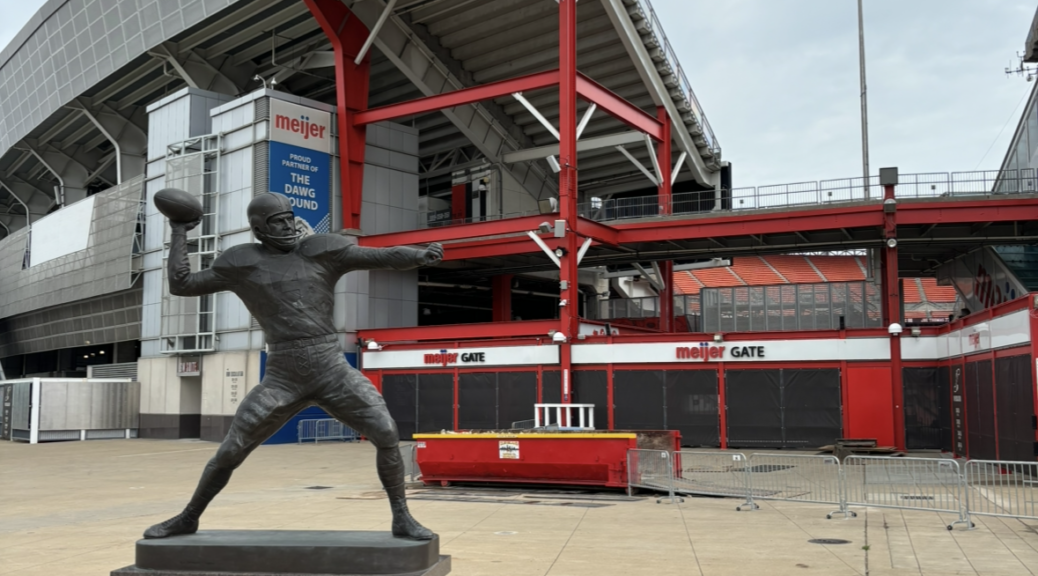
Is There a Right or Wrong Way to Build an NFL Roster?
Roughly 975 billion minutes (about 1,900,000 years) were spent watching the NFL by the 336 million people in the country during 2023. Making the National Football League (NFL), the most watched leagued in the United States.
The end goal for NFL teams is winning the beloved Super Bowl trophy. 32 teams, all completing to complete a singular task. What is the best way to go about this?
There are three ways to acquire talent to a roster, drafting, trading and signing players.
Every year, the NFL hosts a draft where teams select players directly from college. Each team gets one pick in all seven rounds, along with compensatory picks. A compensatory pick is a bonus pick given to teams who lost more players in free agency than they gained.
NFL draftees are given rookie contracts that last four years. Players drafted in the first round have an option for a fifth year.
A second way to acquire players is through trades. Teams can swap assets such as players and picks with other teams. Teams can make trades to clear cap space, acquire starters, depth, draft picks among others.
Players oftentimes have no say of when or who to be traded to. Unless if players have a no-trade clause. A no-trade clause is a built-in agreement in a contract where players can veto a trade involving themselves for whatever reason.
Teams can make trades up to the Tuesday after Week 9. This is the trade deadline, where teams cannot make trades until after the season.
The third and final way to acquire players is through free agency. At the start of every league year, a free agency period starts where teams offer contracts to players who are out of jobs. The only stipulation is teams must stay within the rules of the salary cap.
The salary cap is a number set by the league, limiting the amount of money allowed to be spent on player contracts. The salary cap in 2024 is currently $255.4 million. A 13.6% jump from the 2023 total of $224.8 million.
Teams can sign players year-round; however, most signings take place before the season starts. Sportswriter Thomas Pfeister believes free agency is where the offseason is won and lost.
Teams can sign players year-round; however, most signings take place before the season starts. Sportswriter Thomas Pfeister believes free agency is where the offseason is won and lost.
All three methods have their pros and cons. A combination of these three must be used to build a roster, but when should NFL teams focus on what?
“There is no right choice (of when to use each individual method),” Department Chair and Professor of Economics at Southern Utah University David Berri said.
“Younger players are cheap, generally healthy, but often don’t have enough experience. Older players are likely to know what to do,” Berri said. “There is a wrong way to do it (build a franchise), but not necessarily a right way, ” Pfeister said.
“There is a wrong way to do it (build a franchise), but not necessarily a right way.”
Thomas Pfeister- Sportswriter
“It depends on what direction teams want to go,” NFL fan Preston Raineri said. Generally rebuilding teams focus on the draft, inexperienced teams focus on free agency and teams contending focus on trades.
However, what do the numbers say? Over the last 25 years, what have Super Bowl winning teams done differently than the norm?
When it comes to the draft, teams over the past 25 years have averaged 8.02 picks per year in the seven-round draft. Super Bowl winning teams have spent slightly less than the average.
Since 2000, Super Bowl winning teams on average have spent 8.08 picks two years before winning the Super Bowl, 7.28 three years before and 8.48 four years before. Averaging out to 7.94 picks during the three year stretch two-four years before winning the big game.
Over the same 25-year span since 2000, Super Bowl winning teams have spent more on free agency while being more active in the trade market.
Two years before winning the Super Bowl teams made an average of 4.4 trades per year and 4.96 one year before.
Since 2013, teams on average have spent $188.4 million one year before winning the Super Bowl and $199.1 million two years before.
Both the number of trades and money spent on free agency would put Super Bowl winning teams in the top 10 ranks in the league.
Is there a surefire way to build an NFL franchise? Is there a special secret that successful franchises have kept hidden from less fortunate ones?
The short answer is no. “Luck is huge,” Berri said.
“Quite a bit has to go right for a team to be consistently successful. A team requires contributions from many players to win. And one player missing an assignment can lead to disaster. So… it is complicated,” Berri said.
“(A) Decent amount of luck goes into building a franchise,” Raineri said. “Teams draft late round studs all the time like Tom Brady in the sixth round.”
“Football is not quite as easy as the pundits pretend. Luck plays a huge role in outcomes, and no one has all the answers all the time,” Berri said.
“Football is not quite as easy as the pundits pretend. Luck plays a huge role in outcomes, and no one has all the answers all the time.”
David Berri- Department Chair and Professor of Economics at Southern Utah University
NFL playoffs can be very unpredictable. Most American sports including the MLB, NBA and NHL have playoff rounds lasting seven games. However, each NFL playoff series only lasts one game.
“People can have a bad game in a one game playoff series,” Raineri said. “Turnovers have a huge impact on outcomes in football and those are essentially random. There is virtually no correlation between turnovers per play for players from season-to-season,” Berri said.
“People can have a bad game in a one game playoff series.”
Preston Raineri- NFL Fan
Turnovers can oftentimes be the difference maker, yet they can be so random. “The better team doesn’t always win,” Pfeister said.
Where a team is at and who is running the team may also impact team success.
“Ownership can make it worse,” Berri said. “William Clay Ford (Detroit) and Daniel Snyder (Washington) come to mind. In one case you had an owner that never tried (Ford) and another that interfered too much (Snyder).”
However, with a set salary cap, there is only so much a good owner can do. There is only a certain amount teams can spend each season.
When it comes to a team’s market, there is not much difference as NFL teams share revenue. In 2022, 66% of the NFLs $18.7 billion in revenue was equally allocated to all 32 teams. Which is $584.4 million per team.
Raineri had a different take on this. He argued that bigger markets such as New York and Los Angeles will have more fans leading to a better home field advantage.
Home teams in 2022 won 56.7% of games played. Playing at home has always been an advantage for sports franchises. Less travel and playing in front of the home crowd has led to more wins. However, it is near impossible to quantify how much of an impact home field advantage is.
Should teams blindly follow successful franchises like the New England Patriots who have won six Super Bowl rings since 2002? Hard to answer yes or no.
Too many things go into a franchise to focus on one thing. Pfeister put it best when he said, “There is no right or wrong way to build a franchise as long as you have a plan that is not being consistently mediocre.”



